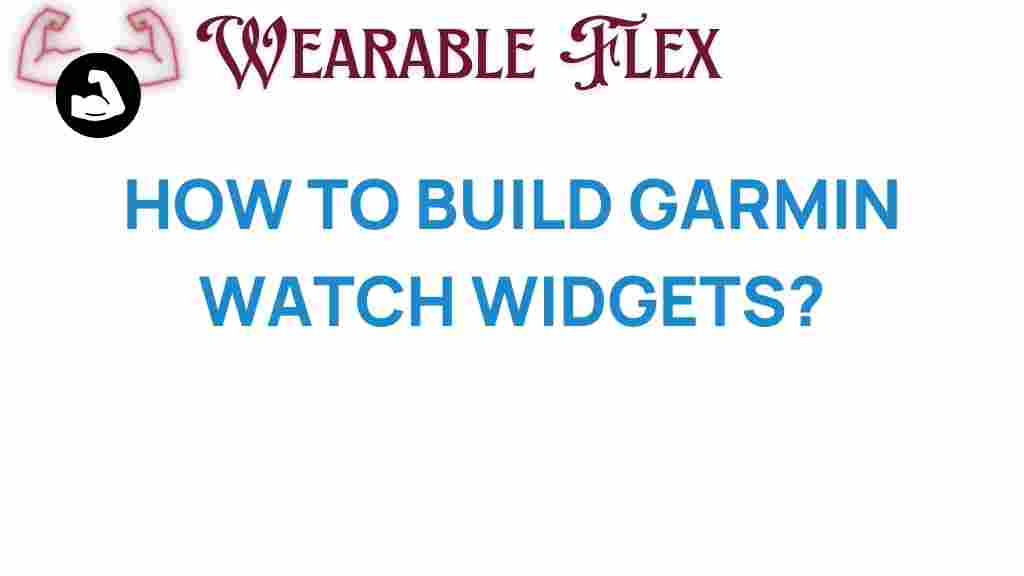Unlocking the Secrets: How to Build Garmin Watch Widgets
In the ever-evolving world of wearable technology, Garmin watches stand out for their functionality and versatility. These devices not only track your fitness but also provide a customizable experience through widgets. Building your own Garmin watch widgets can enhance your watch’s capabilities and give you access to personalized information at a glance. In this article, we will delve into the secrets of creating effective and engaging widgets for your Garmin watch.
What Are Garmin Watch Widgets?
Garmin watch widgets are small applications that display information on your watch face. They can show a variety of data, including:
- Weather updates
- Fitness stats
- Notifications
- Calendar events
- Custom metrics
By creating your own widgets, you can tailor your Garmin watch to suit your needs, making it a more powerful tool for your daily activities.
Why Build Your Own Garmin Watch Widgets?
Building your own widgets offers numerous benefits, including:
- Customization: Design widgets that fit your lifestyle.
- Skill Development: Learn programming skills that can be valuable in many fields.
- Community Contribution: Share your creations with other Garmin users.
Now that you understand the importance of Garmin watch widgets, let’s dive into the step-by-step process of building your own.
Step-by-Step Process to Build Garmin Watch Widgets
Step 1: Set Up Your Development Environment
Before you start building your Garmin watch widgets, you need to set up the necessary tools. Here’s what you need:
- Garmin Connect IQ SDK: Download the SDK from the Garmin Developer Portal.
- IDE: Use an Integrated Development Environment (IDE) like Eclipse or Visual Studio Code.
- Device Simulator: This allows you to test your widgets without needing a physical watch.
Once you have these tools installed, you are ready to start coding!
Step 2: Understand the Connect IQ Language
Garmin watch widgets are developed using the Connect IQ language, which is similar to JavaScript. Familiarize yourself with the following concepts:
- Classes: Encapsulate your data and methods.
- Events: Manage user interactions and device events.
- API Calls: Utilize Garmin’s built-in APIs to access device features.
Check out the Connect IQ Programming Guide for detailed documentation and examples.
Step 3: Create Your First Widget
Let’s build a simple weather widget to get you started:
- Create a New Project: Launch your IDE and create a new Connect IQ project.
- Define Your Widget: Open the “manifest.xml” file and define the widget’s name, type, and other settings.
- Write the Code: In your main widget file, write the code to fetch weather data from an API and display it.
- Test Your Widget: Use the device simulator to run and debug your widget.
Here’s a simple code snippet to display the weather:
class WeatherWidget extends Ui.Widget { function initialize() { // Fetch weather data var weatherData = getWeatherData(); // Display data on screen this.draw(weatherData); }}Step 4: Optimize Your Widget
Once you have a working widget, consider the following optimization tips:
- Performance: Minimize API calls to enhance loading times.
- Battery Life: Ensure your widget does not drain the battery excessively.
- User Experience: Make sure the widget is easy to read and navigate.
Step 5: Publish Your Widget
If you wish to share your creation with the world, you can publish your widget on the Garmin Connect IQ store:
- Register as a Developer: Sign up on the Garmin Developer Portal.
- Submit Your Widget: Follow the guidelines to submit your widget for review.
- Promotion: Share your widget through social media and forums to reach a larger audience.
Troubleshooting Tips
While building your Garmin watch widgets, you may encounter some common issues. Here are some troubleshooting tips to help you out:
Common Issues
- Widget Not Loading: Ensure your API key is valid and check the network connection.
- Crashes on Simulator: Review your code for syntax errors or infinite loops.
- Data Not Displaying: Verify that your data-fetching logic is correct and that you’re processing the data properly.
Resources for Help
If you need more help, consider visiting the Garmin Developer Forums or the official documentation for additional guidance and community support.
Conclusion
Building widgets for your Garmin watch can be a rewarding experience that enhances your daily life. By following the steps outlined in this article, you can create custom widgets that suit your personal needs and preferences. Whether it’s tracking your fitness, receiving timely notifications, or accessing important data, the possibilities are endless.
So, roll up your sleeves, familiarize yourself with the Connect IQ SDK, and start creating your unique Garmin watch widgets today!
This article is in the category Innovations and created by WearableFlex Team

1 thought on “Unlocking the Secrets: How to Build Garmin Watch Widgets”